When brothers Hugh and Donal Ryan started DH Ryan Architects in their hometown of Thurles, Co Tipperary, they were fresh-faced and full of energy; just a few years out of university. Although they both studied abroad at the University of Plymouth, they always felt they would eventually return home to work and live.
Hugh was first to come home. In 2003, he set up Hugh Ryan Architects and promptly started building a clientele.
“I got my first significant job working on a local hotel,” he says. “They wanted a conference centre and a new bedroom block, so that was my first planning application. I’d say I was 23 at the time.”
Donal had graduated a year prior to Hugh and worked in Limerick before being hired by an English architecture firm. He was working between Bristol and Gloucester until 2006, when he decided to take the chance and join his brother in business at home.
“I was mainly in Bristol,” he says. “I loved working there, but I always wanted to be able to work for myself – to see the project from start to finish, meet the clients and get fully involved. I saw the economy was doing well, so I handed in my notice and decided to go home.”
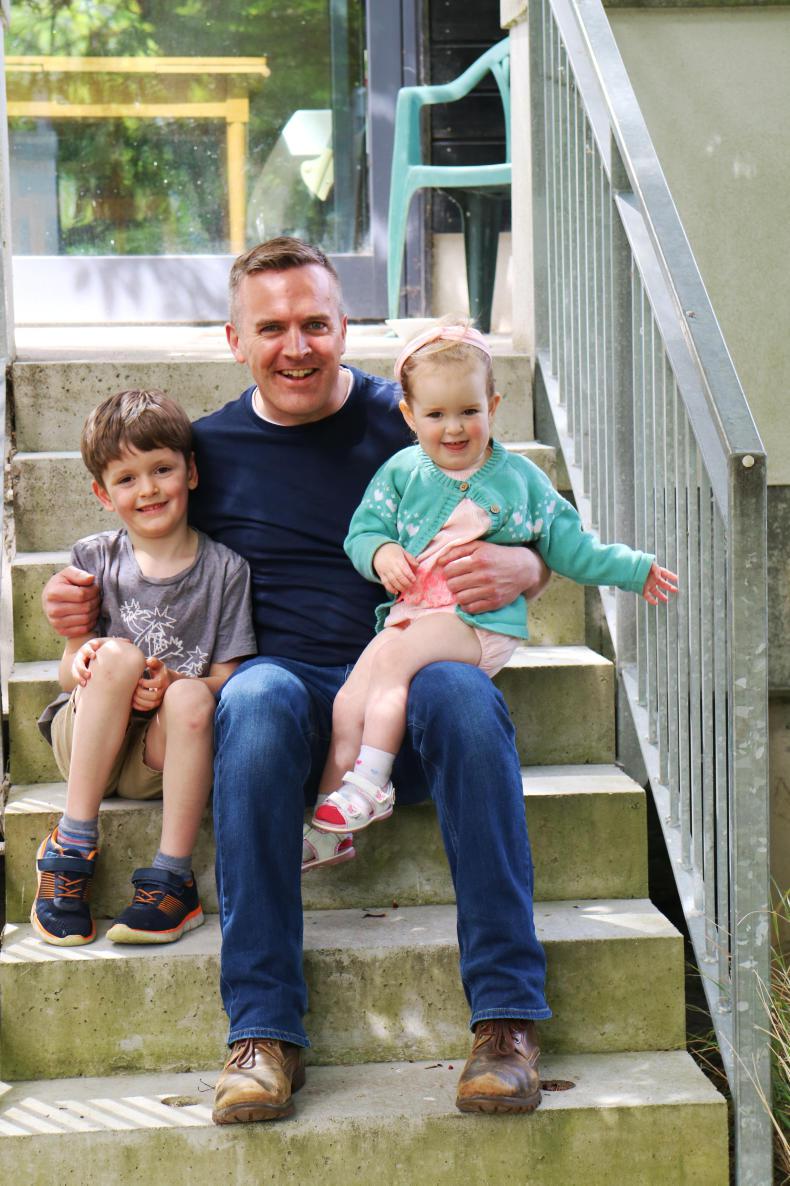
Donal Ryan his two children Daniel (six) and Roisin (two).
“He was like a jinx on the economy,” Hugh jokes.
“Yeah, so when I came home, it all crashed,” Donal laughs. “But, at the time, we were working out of our parents’ house; we had no major overheads, really.”
As the brothers became busier, they moved office to Liberty Square in Thurles, eventually taking up residence in a space with familial significance.
“We first had a place on the other side of the square,” Donal says. “We were there for about five years but it was too big for what we needed, so we started looking around for somewhere else to rent. The place we found, and where we operate now, was actually our father’s home house.”
“Our grandfather built it,” Hugh explains. “Originally, there was a shop on the ground floor with a pub and it was where our family’s undertaking business was located. It was where Dad grew up.”
Having the family connection, our father being known around the area, having a recognisable name – word of mouth has been a good way of generating business
“And our mother worked for the council, next door, where my office space is located; the two buildings are now one,” Donal continues. “It was in our family for about 140 years and then sold when the last of the family moved out, so us being there is special. Having the family connection, our father being known around the area, having a recognisable name – word of mouth has been a good way of generating business.”
The Bannon effect
In recent years, architecture has surged in popularity. This is largely thanks to television shows like Grand Designs and Room to Improve, which have encouraged more Irish consumers to appreciate the value of employing a registered architect and develop an interest in bespoke design.
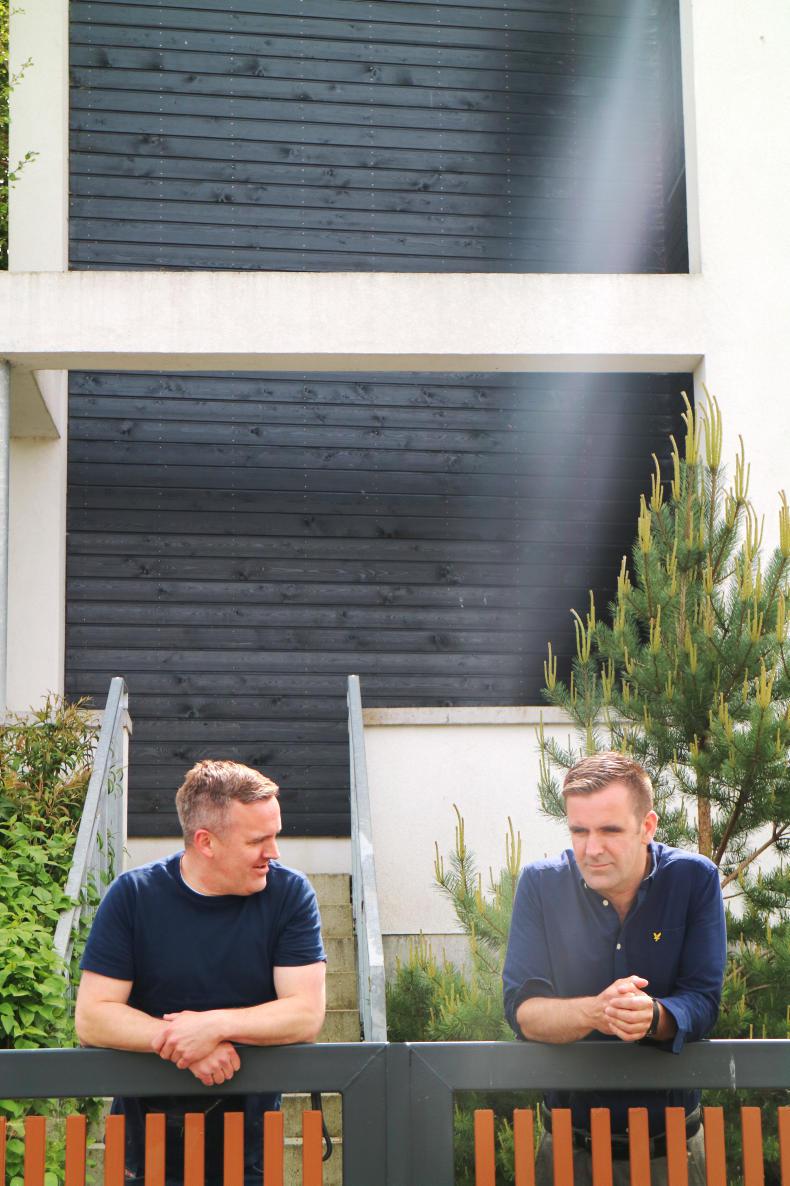
Hugh and Donal not only share their architecture business; they also lend a hand in the family-run undertakers business,Hugh Ryan’s Funeral Home.
“Architects will analyse a building site; looking at its orientation, views, surrounding landscape, and access and develop a design based on both this analysis and the clients’ brief,” Donal explains. “Each site is unique just like every client is unique; you can’t just take a bog-standard house and drop it onto a site – that doesn’t make any sense. By working with an architect, there’s so much potential for innovation.”
“Traditional Irish houses – particularly farmhouses – originally would have been informed by the landscape and its microclimate,” Hugh adds. “It took time to build anything, back in the day – people didn’t have access to the type of equipment or materials they do today, so they put a lot of thought into it. So they were actually pretty good architects 100 or 200 years ago.”
Past generations of builders understood the weather, where the sun rises and sets, they understood the benefit of building in an area that was sheltered from damp and cold winds
In the 1970s and 80s, the main trend became selecting house plans from a book. These houses often looked well on paper, but had no connection to individual context or the end user. The brothers explain that there was usually no intention behind those houses, whereas older farmhouses would have been built with a purpose; taking the landscape and weather into account before being built. Now, in a move away from catalogue homes, consumers appear to see the value in the way traditional homes would work with the landscape.
“Past generations of builders understood the weather, where the sun rises and sets, they understood the benefit of building in an area that was sheltered from damp and cold winds,” Donal says. “Those farmhouses can be quite energy efficient, as well, because of their thermal mass – there was careful consideration, in those days, into what would work and what would keep them warm and comfortable.”
Hugh and Donal believe the popularity of architectural television shows in recent years has led to an increase in creativity toward modern Irish home design.
“People are better informed, now,” Donal says. “I think those programmes are brilliant; a lot of people give out about them, but I imagine in the past people might have thought, ‘Jeez, everyone will think I have high notions of myself if I design something different’. Now, people are saying, ‘Oh, actually, it’s OK to try things that are a little bit different; it doesn’t all have to be the same’.”
Design Approach
Hugh and Donal encourage their clients to get involved in the design process, which, for them, is the most exciting aspect of their work.
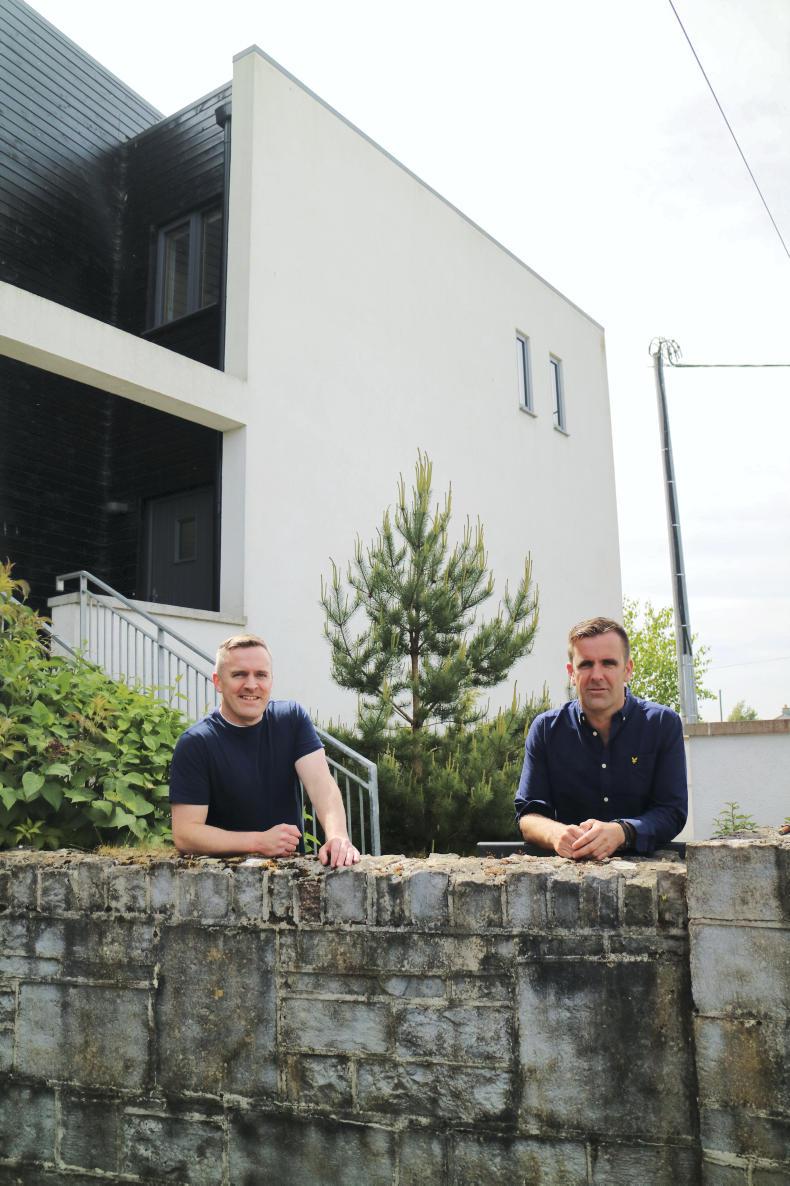
“The most enjoyable part of our job is the design itself,” Donal says. “For the majority of houses, we would start with our own thoughts on how best to approach the design, but it’s always made better by the input of the client. If I’m working on a refurbishment or extension, I can never understand a house as well as someone who’s living there. There are so many things we wouldn’t understand properly, if the client wasn’t involved in the process.
“For new builds, we always say to people that it’s their house. We can help guide you in the right direction, but we want you to be involved in the design. We always ask, ‘What’s important to you? What have you enjoyed about homes you’ve had in the past? What have you detested?’ All of this information and more is fed through in the design, so we can create something that’s completely informed by you.”
Family Matters
Hugh and Donal not only share their architecture business; they also lend a hand in the family-run undertakers business, Hugh Ryan’s Funeral Home. Their father Dan Ryan has held many titles throughout his 86 years, but his work as a funeral director has always held great importance; having been passed through generations.
“Dad is an undertaker, but he previously had a wooden toy factory, was involved in horse shows, hunting and horse racing, made coffins and had a picture-framing business,” Hugh says. “He used to make wooden toys under licence for a German company. He had a warehouse on Croke Street in the 60s, 70s and early 80s. He was even on the first-ever Late Late Toy Show in 1976. His grandfather (Hugh Ryan) was involved in the founding of the GAA at Hayes Hotel in 1884 and was one of three men to organise the first All-Ireland in Birr between Tipperary and Galway in 1888.”
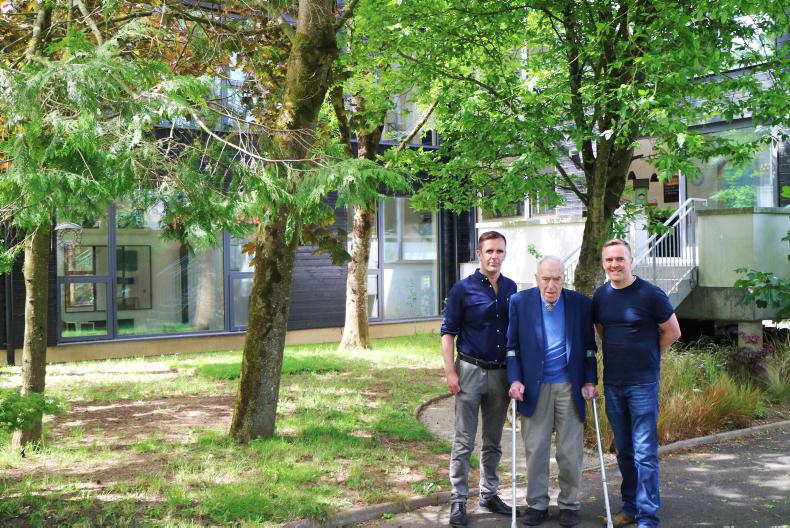
Hugh and Donal Ryan with their 86-year-old father Dan who is a local undertaker.
“That same grandfather set up the undertaking business in 1878,” Donal adds.
Dan and his younger brother, Johnny (who has since passed), worked together to run the undertakers business and, through the years, searched for a site to build a dedicated funeral home. Their aim was to provide, and have full control over, a complete professional service to the bereaved. It took about 30 years to find the right space, but they opened their new funeral home in the centre of Thurles in 2016. As the premises was developed, it was handy that both of Dan’s sons happened to be architects.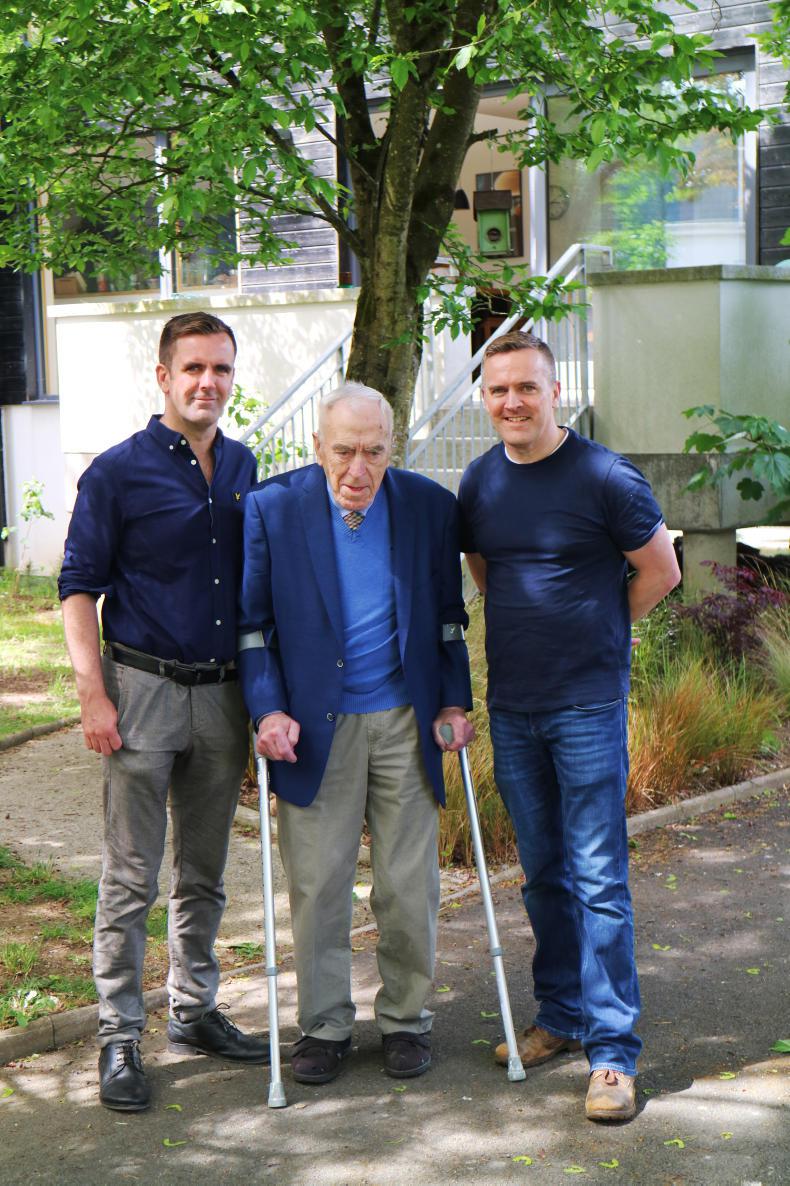
“Our cousin David is involved with the undertaking business full time; we slip in and out when needed,” Donal says. “With our background, we were able to help work out the logistics of the funeral home. We studied trends and saw that many funeral homes were looking to increase capacity to accommodate larger crowds. We had to ensure the spaces were suitable and that flexibility was considered, so we offer three different chapels to accommodate different-sized gatherings.”
For the Ryans, the importance of providing shelter and comfort to those gathering to pay their respects is paramount. The brothers say that, for some, funerals are also the only times to reconnect with friends or family, so it was important that this was recognised in the design, as well, with areas to sit down and catch up in comfort. Capacity to accommodate long queues in inclement weather was also critical.
“It’s been great for Dad to see the fruits of his hard work, considering his patience in taking the time to find the right site,” Donal says. “The many compliments received about the funeral home has been satisfying and its success has ensured the continuation of the business for future generations.”
The brothers also tell Irish Country Living that they secure many of their architecture clients through word of mouth, so making sure their father – a well-respected figure in the community – is happy has done them no harm!
When brothers Hugh and Donal Ryan started DH Ryan Architects in their hometown of Thurles, Co Tipperary, they were fresh-faced and full of energy; just a few years out of university. Although they both studied abroad at the University of Plymouth, they always felt they would eventually return home to work and live.
Hugh was first to come home. In 2003, he set up Hugh Ryan Architects and promptly started building a clientele.
“I got my first significant job working on a local hotel,” he says. “They wanted a conference centre and a new bedroom block, so that was my first planning application. I’d say I was 23 at the time.”
Donal had graduated a year prior to Hugh and worked in Limerick before being hired by an English architecture firm. He was working between Bristol and Gloucester until 2006, when he decided to take the chance and join his brother in business at home.
“I was mainly in Bristol,” he says. “I loved working there, but I always wanted to be able to work for myself – to see the project from start to finish, meet the clients and get fully involved. I saw the economy was doing well, so I handed in my notice and decided to go home.”

Donal Ryan his two children Daniel (six) and Roisin (two).
“He was like a jinx on the economy,” Hugh jokes.
“Yeah, so when I came home, it all crashed,” Donal laughs. “But, at the time, we were working out of our parents’ house; we had no major overheads, really.”
As the brothers became busier, they moved office to Liberty Square in Thurles, eventually taking up residence in a space with familial significance.
“We first had a place on the other side of the square,” Donal says. “We were there for about five years but it was too big for what we needed, so we started looking around for somewhere else to rent. The place we found, and where we operate now, was actually our father’s home house.”
“Our grandfather built it,” Hugh explains. “Originally, there was a shop on the ground floor with a pub and it was where our family’s undertaking business was located. It was where Dad grew up.”
Having the family connection, our father being known around the area, having a recognisable name – word of mouth has been a good way of generating business
“And our mother worked for the council, next door, where my office space is located; the two buildings are now one,” Donal continues. “It was in our family for about 140 years and then sold when the last of the family moved out, so us being there is special. Having the family connection, our father being known around the area, having a recognisable name – word of mouth has been a good way of generating business.”
The Bannon effect
In recent years, architecture has surged in popularity. This is largely thanks to television shows like Grand Designs and Room to Improve, which have encouraged more Irish consumers to appreciate the value of employing a registered architect and develop an interest in bespoke design.

Hugh and Donal not only share their architecture business; they also lend a hand in the family-run undertakers business,Hugh Ryan’s Funeral Home.
“Architects will analyse a building site; looking at its orientation, views, surrounding landscape, and access and develop a design based on both this analysis and the clients’ brief,” Donal explains. “Each site is unique just like every client is unique; you can’t just take a bog-standard house and drop it onto a site – that doesn’t make any sense. By working with an architect, there’s so much potential for innovation.”
“Traditional Irish houses – particularly farmhouses – originally would have been informed by the landscape and its microclimate,” Hugh adds. “It took time to build anything, back in the day – people didn’t have access to the type of equipment or materials they do today, so they put a lot of thought into it. So they were actually pretty good architects 100 or 200 years ago.”
Past generations of builders understood the weather, where the sun rises and sets, they understood the benefit of building in an area that was sheltered from damp and cold winds
In the 1970s and 80s, the main trend became selecting house plans from a book. These houses often looked well on paper, but had no connection to individual context or the end user. The brothers explain that there was usually no intention behind those houses, whereas older farmhouses would have been built with a purpose; taking the landscape and weather into account before being built. Now, in a move away from catalogue homes, consumers appear to see the value in the way traditional homes would work with the landscape.
“Past generations of builders understood the weather, where the sun rises and sets, they understood the benefit of building in an area that was sheltered from damp and cold winds,” Donal says. “Those farmhouses can be quite energy efficient, as well, because of their thermal mass – there was careful consideration, in those days, into what would work and what would keep them warm and comfortable.”
Hugh and Donal believe the popularity of architectural television shows in recent years has led to an increase in creativity toward modern Irish home design.
“People are better informed, now,” Donal says. “I think those programmes are brilliant; a lot of people give out about them, but I imagine in the past people might have thought, ‘Jeez, everyone will think I have high notions of myself if I design something different’. Now, people are saying, ‘Oh, actually, it’s OK to try things that are a little bit different; it doesn’t all have to be the same’.”
Design Approach
Hugh and Donal encourage their clients to get involved in the design process, which, for them, is the most exciting aspect of their work.

“The most enjoyable part of our job is the design itself,” Donal says. “For the majority of houses, we would start with our own thoughts on how best to approach the design, but it’s always made better by the input of the client. If I’m working on a refurbishment or extension, I can never understand a house as well as someone who’s living there. There are so many things we wouldn’t understand properly, if the client wasn’t involved in the process.
“For new builds, we always say to people that it’s their house. We can help guide you in the right direction, but we want you to be involved in the design. We always ask, ‘What’s important to you? What have you enjoyed about homes you’ve had in the past? What have you detested?’ All of this information and more is fed through in the design, so we can create something that’s completely informed by you.”
Family Matters
Hugh and Donal not only share their architecture business; they also lend a hand in the family-run undertakers business, Hugh Ryan’s Funeral Home. Their father Dan Ryan has held many titles throughout his 86 years, but his work as a funeral director has always held great importance; having been passed through generations.
“Dad is an undertaker, but he previously had a wooden toy factory, was involved in horse shows, hunting and horse racing, made coffins and had a picture-framing business,” Hugh says. “He used to make wooden toys under licence for a German company. He had a warehouse on Croke Street in the 60s, 70s and early 80s. He was even on the first-ever Late Late Toy Show in 1976. His grandfather (Hugh Ryan) was involved in the founding of the GAA at Hayes Hotel in 1884 and was one of three men to organise the first All-Ireland in Birr between Tipperary and Galway in 1888.”

Hugh and Donal Ryan with their 86-year-old father Dan who is a local undertaker.
“That same grandfather set up the undertaking business in 1878,” Donal adds.
Dan and his younger brother, Johnny (who has since passed), worked together to run the undertakers business and, through the years, searched for a site to build a dedicated funeral home. Their aim was to provide, and have full control over, a complete professional service to the bereaved. It took about 30 years to find the right space, but they opened their new funeral home in the centre of Thurles in 2016. As the premises was developed, it was handy that both of Dan’s sons happened to be architects.
“Our cousin David is involved with the undertaking business full time; we slip in and out when needed,” Donal says. “With our background, we were able to help work out the logistics of the funeral home. We studied trends and saw that many funeral homes were looking to increase capacity to accommodate larger crowds. We had to ensure the spaces were suitable and that flexibility was considered, so we offer three different chapels to accommodate different-sized gatherings.”
For the Ryans, the importance of providing shelter and comfort to those gathering to pay their respects is paramount. The brothers say that, for some, funerals are also the only times to reconnect with friends or family, so it was important that this was recognised in the design, as well, with areas to sit down and catch up in comfort. Capacity to accommodate long queues in inclement weather was also critical.
“It’s been great for Dad to see the fruits of his hard work, considering his patience in taking the time to find the right site,” Donal says. “The many compliments received about the funeral home has been satisfying and its success has ensured the continuation of the business for future generations.”
The brothers also tell Irish Country Living that they secure many of their architecture clients through word of mouth, so making sure their father – a well-respected figure in the community – is happy has done them no harm!






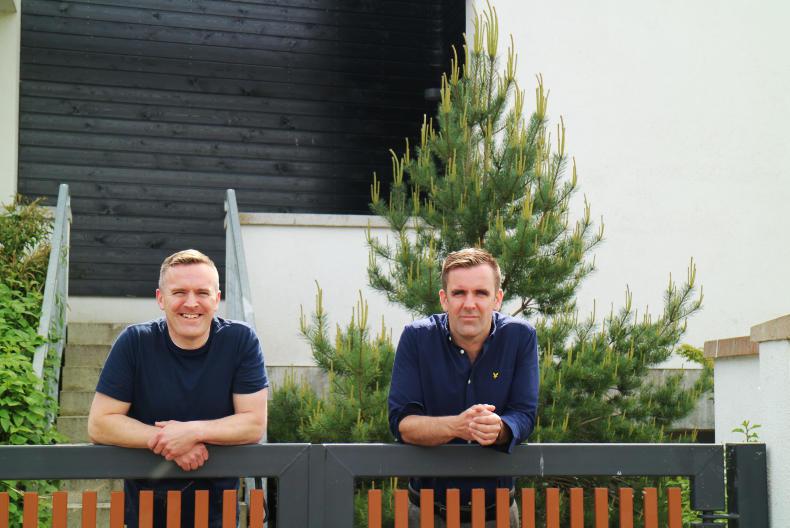




 This is a subscriber-only article
This is a subscriber-only article










SHARING OPTIONS: